#faubourg saint antoine
Photo

Chairs in Passage du Chantier
#faubourg saint antoine#a paris#antique furniture#fauteils#paris street photography#french vibes#parisienne#parisian vibes#cobblestone#secret passage#secret#passage#parisian chic#lesparisiennesdumonde#alafrancaise#vintage furniture#antique decor#meubles#art studio
51 notes
·
View notes
Text

1986 Paris, rue du Faubourg Saint-Antoine
#1986#Paris#Rue du Faubourg Saint-Antoine#photography#original photographers#blackandwhite#streetphotography#analog photography#1980s#film photography#vintage#pierre wayser
15 notes
·
View notes
Text

#paris#france#streets#people#darkness#light#rain#pluie#woman#femme#rue du faubourg saint antoine#75012#bastille
10 notes
·
View notes
Text
Toevallige ontmoeting met dodelijke afloop
Het was niet eens de échte revolutie van 1848, die van februari, die een eind maakte aan het bewind van de ‘burger-koning’ Louis-Philippe en van Frankrijk weer een republiek maakte (de tweede, na de eerste tijdens de Franse revolutie). In juni van datzelfde jaar kwamen zo’n 20.000 Parijse arbeiders en handwerkslieden in opstand, omdat zij zich verraden voelden. In februari had de massa gestreden…

View On WordPress
#1848#1851#algemeen kiesrecht#Ateliers nationaux#ballingschap#barricade#Bastille#Brest#Commune van Parijs#daguerrotype#duel#Emmanuel Barthélemy#Engeland#Faubourg du Temple#Faubourg Saint-Antoine#februari 1848#Frankrijk#Frédéric Cournet#Guernesey#Guernsey#Herzen#Horace Vernet#juni 1848#Jusqu&039;à ce que mort s&039;ensuive#Ledru-Rollin#Les misérables#Londen#Louis Blanc#Louis Blanqui#Louis-Philippe
0 notes
Text
Les Mis Canon-era Paris Photographs: Jean Valjean and Cosette’s route to escape Javert, in Pictures!

Jean Valjean's escape through Paris is Victor Hugo's way of mourning the Paris he knew from before his exile, the Paris before the modern renovations.
Hugo wrote Les Mis from exile in Guernsey, at the same time as Paris was undergoing a series of massive renovations. The "Old City" of medieval Paris that Hugo loved was being replaced by the “New City" of Baron Haussman. The dark medieval labyrinth lit by oil lamps was being replaced by modern wide streets and standardized architecture lit by gas lamps. Victor Hugo is nostalgic for the Paris he remembers before his exile-- so Jean Valjean is able to escape Javert using things unique to the Old City. He escapes through a labyrinth of tiny medieval streets in a neighborhood Hugo claims was destroyed during the renovations; he climbs over the convent wall using the rope from an oil lamp, the very oil lamps that were being replaced by the more modern gas lanterns. The dark maze hides him from police surveillance in a way modern streets cannot.
A man named Charles Marville photographed Paris shortly before many (though not all) of the renovations occurred. In this post I'll go through all the different streets mentioned in the Valjean-Javert Paris chase chapters, and provide Marville's photographs whenever they the image has been labeled with the name of the street. Note that there may be some inaccuracies. Some street names changed over time.
Here is a map of what the chase looks like, taken from the book "Paris in the Times of Victor Hugo."
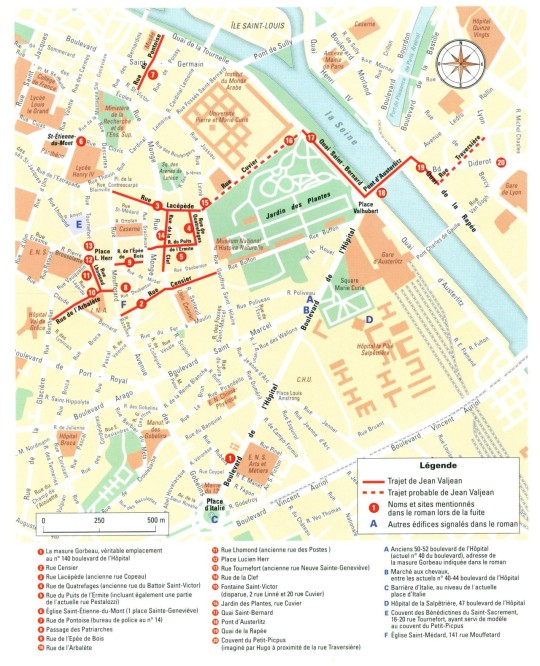
A quick overview: Jean Valjean starts in a slummy half-built suburban area. This area is highly associated with the King; the royal Jardin des Plantes is nearby, and King Louis XVIII often rides by in his carriage during the afternoons. After travelling down a bunch of streets, "zigzagging" back and forth, Jean Valjean decides to cross the Seine over the Bridge of Austerlitz (a bridge named after one of Napoleon's victories.) Then he reaches the areas of the city near the Faubourg Saint Antoine that are more associated with working class rebellion. From there he enters a dark isolated half-built medieval neighborhood near marshes and timberyards, with narrow mazey alleyways, that Hugo mostly made up. Hugo pretends this medieval neighborhood used to exist, but was destroyed like many others during the recent renovations. Now that we've gotten the overview out of the way, let's go more specific!
The chase starts out in "the old quarter of the Marche aux Chevaux." At the time, this was a less inhabited and poorer area of Paris; it's described as basically a slum. Here are some of Marville's photographs :

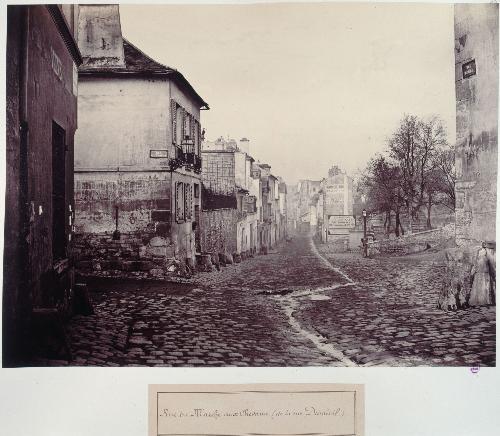
Then we're told "Jean Valjean described many and varied labyrinths in the Mouffetard quarter, which was already asleep, as though the discipline of the Middle Ages and the yoke of the curfew still existed. He combined in various manners, with cunning strategy, the Rue Censier:"
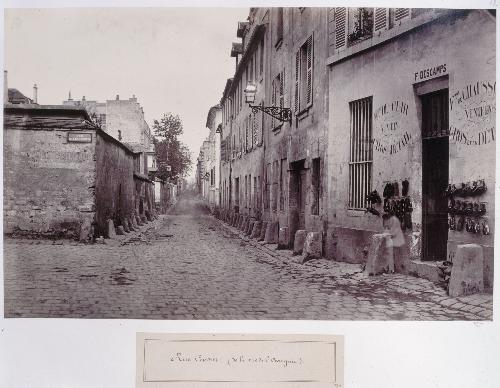
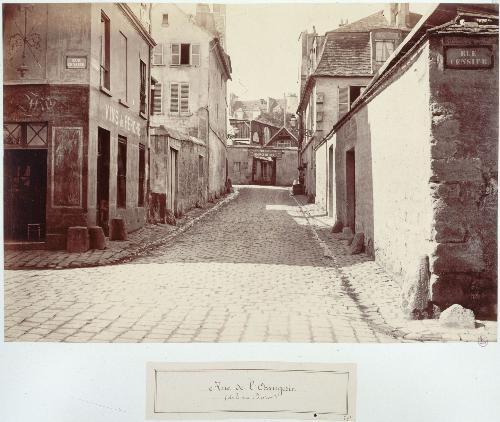


"and the Rue Copeau," (according to the map I linked earlier, the Rue Copeau is now the Rue Lacepede. Here is Marville's pic:)

"the Rue du Battoir-Saint-Victor and the Rue du Puits l’Ermite. There are lodging houses in this locality, but he did not even enter one, finding nothing which suited him. He had no doubt that if any one had chanced to be upon his track, they would have lost it."
"As eleven o’clock struck from Saint-Étienne-du-Mont:" (note: this refers to the church of Saint-Etienne)

"he was traversing the Rue de Pontoise, in front of the office of the commissary of police, situated at No. 14." (Jean Valjean sees Javert and the police following him on this street, because they're visible in the light of the lantern from the police station.)
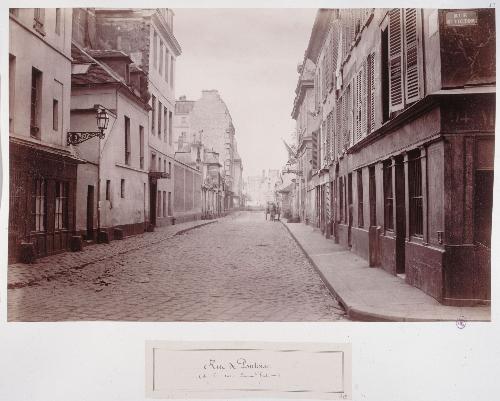
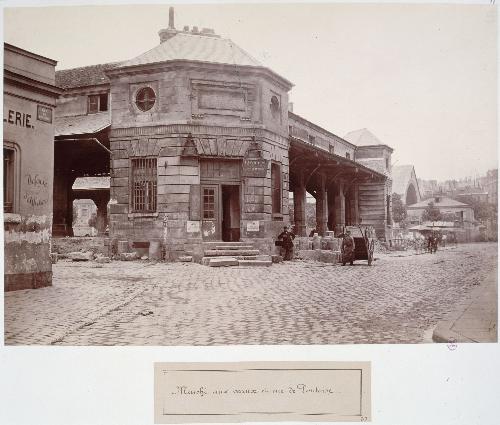
"He took a circuit, turned into the Passage des Patriarches, which was closed on account of the hour,"
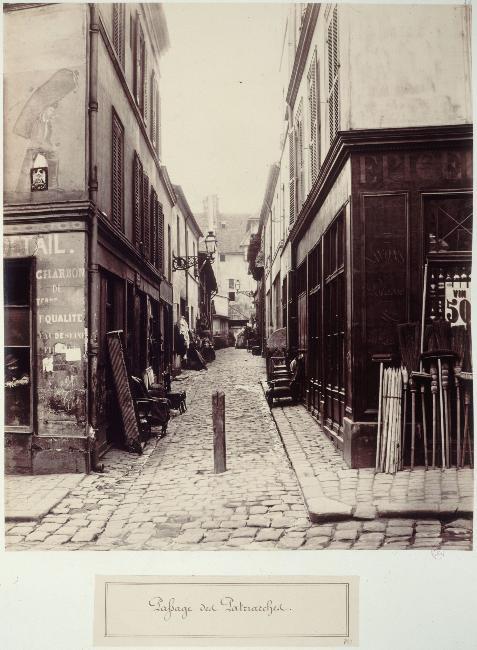
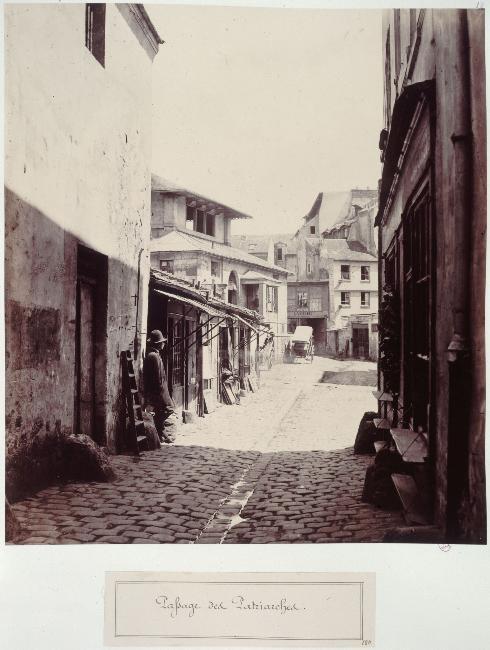
"strode along the Rue de l’Épée-de-Bois

and the Rue de l’Arbalète, and plunged into the Rue des Postes."




"At that time there was a square formed by the intersection of streets, where the College Rollin stands to-day, and where the Rue Neuve-Sainte-Geneviève turns off." (Note: these streets are labeled Montagne-Sainte-Geneviève, but not Neuve-Sainte-Geneviève, so they may be different streets! But I'm putting them here anyway.)
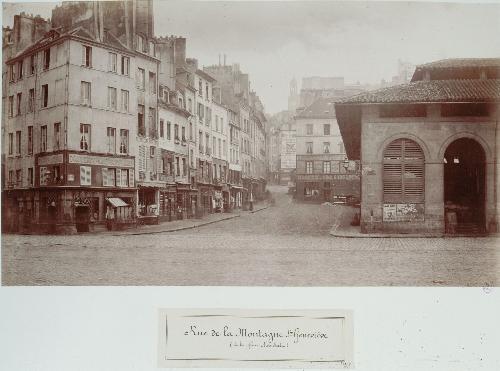


"It is understood, of course, that the Rue Neuve-Sainte-Geneviève is an old street, and that a posting-chaise does not pass through the Rue des Postes once in ten years. In the thirteenth century this Rue des Postes was inhabited by potters, and its real name is Rue des Pots." (Annotation: Hugo's bein silly and making little puns. He's snarkily pointing out the "new saint-genevieve street" is old, and the post street rarely has post-chaises/carriages go through it.)
(Jean Valjean hides in the shadows and watches to see who shows up in this big square intersection of streets. In the moonlight, he recognizes Javert.)
"He slipped from under the gate where he had concealed himself, and went down the Rue des Postes (which I shared a picture of previously), towards the region of the Jardin des Plantes." (Note: the Jardin des Plantes is a royal garden. Here is a modern photo from Wikipedia.)

"He left behind him the Rue de la Clef,

"then the Fountain Saint-Victor, skirted the Jardin des Plantes by the lower streets, and reached the quay. There he turned round. The quay was deserted. The streets were deserted. There was no one behind him. He drew a long breath.
He gained the Pont d’Austerlitz."
(The Pont d'Austerlitz, named after Napoleon's victory at the battle of Austerlitz, is a very famous bridge. Marville has no photographs but here's an 1830 engraving:)

"The bridge once crossed, he perceived some timber-yards on his right. He directed his course thither. In order to reach them, it was necessary to risk himself in a tolerably large unsheltered and illuminated space. He did not hesitate. Those who were on his track had evidently lost the scent, and Jean Valjean believed himself to be out of danger. Hunted, yes; followed, no."
Here's the quai by the pont-au-change-- a different quai, but gives you an idea of what the areas around the Seine often looked like.
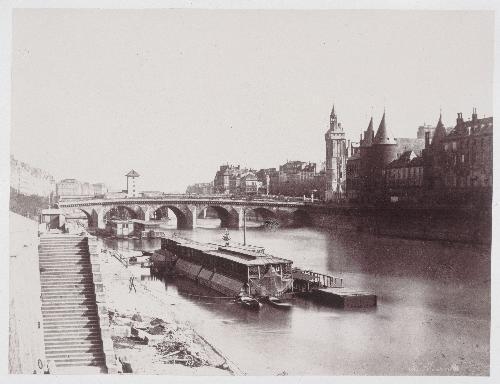
(Then Jean Valjean sees Javert and the other police on the Bridge of Austerlitz, following him. He hurries towards the darker alleys of the city.)
"A little street, the Rue du Chemin-Vert-Saint-Antoine, opened out between two timber-yards enclosed in walls. This street was dark and narrow and seemed made expressly for him."
Here's an abandoned timber-yard-ish looking picture:

But Marville has no photographs of this street. I'd have to double check, but iirc this is the part where Hugo starts to 'make up' more street layouts. I wouldn't be surprised if this street really WAS made expressly for him (meaning Hugo made it up.)
"The point of Paris where Jean Valjean found himself, situated between the Faubourg Saint-Antoine and la Râpée, is one of those which recent improvements have transformed from top to bottom,—resulting in disfigurement according to some, and in a transfiguration according to others. The market-gardens, the timber-yards, and the old buildings have been effaced. To-day, there are brand-new, wide streets, arenas, circuses, hippodromes, railway stations, and a prison, Mazas, there; progress, as the reader sees, with its antidote."
(Here Hugo talks about the Haussman renovations directly, claiming that if his street layouts are "inaccurate" it's because these are some of the Old Medieval Streets that were razed during Paris's recent renovations. He goes on for a while comparing Petit-Picpus to various other areas that were changed during the renovations.)
"Le Petit-Picpus, which, moreover, hardly ever had any existence, and never was more than the outline of a quarter, had nearly the monkish aspect of a Spanish town. The roads were not much paved; the streets were not much built up. (....) Such was this quarter in the last century. The Revolution snubbed it soundly. The republican government demolished and cut through it. Rubbish shoots were established there. Thirty years ago, this quarter was disappearing under the erasing process of new buildings. To-day, it has been utterly blotted out."
The Petit-Picpus, of which no existing plan has preserved a trace, is indicated with sufficient clearness in the plan of 1727, published at Paris by Denis Thierry, Rue Saint-Jacques, opposite the Rue du Plâtre;

and at Lyons, by Jean Girin, Rue Mercière, at the sign of Prudence.
Petit-Picpus had, as we have just mentioned, a Y of streets, formed by the Rue du Chemin-Vert-Saint-Antoine, which spread out in two branches, taking on the left the name of Little Picpus Street, and on the right the name of the Rue Polonceau. The two limbs of the Y were connected at the apex as by a bar; this bar was called Rue Droit-Mur.
The Rue Polonceau ended there; Rue Petit-Picpus passed on, and ascended towards the Lenoir market. A person coming from the Seine reached the extremity of the Rue Polonceau, and had on his right the Rue Droit-Mur, turning abruptly at a right angle, in front of him the wall of that street, and on his right a truncated prolongation of the Rue Droit-Mur, which had no issue and was called the Cul-de-Sac Genrot."
Here is @everyonewasabird's attempt to puzzle this out:

It was here that Jean Valjean stood."
Then Jean Valjean escapes by pulling down an old oil lantern, strung up by ropes. Hugo notes that this would have been "impossible if the streets were lit with gas, the way they would be after the renovations. This picture shows an old oil lamp strung up by ropes:

Finally, Jean Valjean climbs over the wall into the Petit-Picpus convent. This convent is fictional. Hugo pretends it used to exists but is no longer around-- another relic of the early 19th century that has been lost over time.
TLDR:
Jean Valjean's escape through Paris is Hugo way of mourning the Paris he knew from before his exile, the Paris before the modern renovations. To quote Volume 2 Book 5 Chapter 1:
The author of this book, who regrets the necessity of mentioning himself, has been absent from Paris for many years. Paris has been transformed since he quitted it. A new city has arisen, which is, after a fashion, unknown to him. There is no need for him to say that he loves Paris: Paris is his mind’s natal city. In consequence of demolitions and reconstructions, the Paris of his youth, that Paris which he bore away religiously in his memory, is now a Paris of days gone by. He must be permitted to speak of that Paris as though it still existed. It is possible that when the author conducts his readers to a spot and says, “In such a street there stands such and such a house,” neither street nor house will any longer exist in that locality. Readers may verify the facts if they care to take the trouble. For his own part, he is unacquainted with the new Paris, and he writes with the old Paris before his eyes in an illusion which is precious to him. It is a delight to him to dream that there still lingers behind him something of that which he beheld when he was in his own country, and that all has not vanished. So long as you go and come in your native land, you imagine that those streets are a matter of indifference to you; that those windows, those roofs, and those doors are nothing to you; that those walls are strangers to you; that those trees are merely the first encountered haphazard; that those houses, which you do not enter, are useless to you; that the pavements which you tread are merely stones. Later on, when you are no longer there, you perceive that the streets are dear to you; that you miss those roofs, those doors; and that those walls are necessary to you, those trees are well beloved by you; that you entered those houses which you never entered, every day, and that you have left a part of your heart, of your blood, of your soul, in those pavements. All those places which you no longer behold, which you may never behold again, perchance, and whose memory you have cherished, take on a melancholy charm, recur to your mind with the melancholy of an apparition, make the holy land visible to you, and are, so to speak, the very form of France, and you love them; and you call them up as they are, as they were, and you persist in this, and you will submit to no change: for you are attached to the figure of your fatherland as to the face of your mother.
143 notes
·
View notes
Text
I have polls! Which means we can settle this once and for all:
121 notes
·
View notes
Text
We now turn to revolutionary groups like Les Amis de l’ABC!
The Faubourg Saint-Antoine was a primarily working class area known for its revolutionary sentiments. That combination of ideological motives (its revolutionary history) and economic ones (its working class inhabitants would be more affected by the financial turbulence of the early 1830s) helps explain why it would be the focus within Paris (and Paris, of course, would be the focus in France because of its history and its status as the capital). Hugo addresses this later on in the chapter as well.
Another quick historical note: some of the lines in this chapter come from actual documents! According to the notes in the Donougher translation, the section on “The passages which touched the crowd most deeply” draws heavily on a judicial inquiry into the events of April 1834 (government troops fired on the inhabitants of a building). This is also true of many of the references to committees. By mixing real quotations with documents of his own making, Hugo lends legitimacy to his historical claims as he further immerses us in the atmosphere of the time.
Part of that atmosphere was the constant fear of being caught by the authorities. The reference to “Babeuf” really being “Gisquet” is an allusion to the prefect of police; we can also see that fear in accusations of some being “spies,” and the implication that organizations kept an eye on their own members. Secrecy was necessary to operate, but it was stressful, too. Those organizing couldn’t be too lax in who they trusted with the real possibility of arrest being ever-present. This isn’t to say an atmosphere of total suspicion prevailed – Les Amis clearly all trust each other, as a “family,” and discontent was commonly spoken of in the street – but that was all combined with caution. It’s less “no one trusted each other” and more Valjean’s porter being suspicious of Marius; there was plenty of solidarity between workers especially and people disfavored by monarchy more broadly, but there was also an awareness of what could be unsafe and who looked suspicious.
We also get a better notion of the range of ideas! The man accused of being a spy is more economically radical than we’ve heard so far, and is suspicious of republicans. Of course, we don’t know if this specific man is trustworthy, but it does suggest that people were questioning the existence of private property and similar ideas, and that republicanism itself came under suspicion in some circles (probably because of the “compromise rule” of Louis Philippe). (There are also explicit references to communists later on). These groups are also very working class compared to Les Amis, who are mostly defined as students (with the notable exception of Feuilly). They could have origins in the working or middle classes (Bahorel was a student, but from a peasant background!), but these organizations are definitely of the working class. There are allusions to bourgeois joining in, but they’re not the main focus here.
Hugo’s use of the word “savage” at the end of the chapter is uncomfortable, but it’s an intentional discomfort. For being violent (and lower class), that is exactly the kind of language that would have been used to describe them in critical writings at the time. Many in Hugo’s audience, for instance, may have found their specific ideas (like greater democracy, less poverty, an end to the death penalty, etc) quite convincing, but may have disagreed with their means (rebellion). Hugo ends on a Combeferre-like note of gradual progress that is less violent, but we should keep in mind that both of them end up affiliated with republicans here on the grounds that their violence is the better option. The “civilized men of barbarism” look peaceful, but are ultimately more harmful, allowing injustices as long as they are out of sight. Hugo’s use of “savage,” then, was intended to push his audience to question who was really “barbaric”: a person rebelling because their rights were denied to them, or someone denying the rights of others?
#Les mis letters#lm 4.1.5#I’m sure I missed a lot because this is a long chapter#And there’s so much to say about how people organized and how Hugo portrays them!#It’s such an interesting peek into the activity of the period
46 notes
·
View notes
Text

An armchair that had once belonged to Soult, sold at an auction. From the catalogue:
The furniture originally comprised at least six armchairs, two bergères, four chairs, a chest of drawers, a bed and a somno. This furniture was commissioned by Marshal Soult, probably around 1805. It is mentioned in 1810 in the bedroom of Monseigneur le Duc among the Marshal's papers, kept at the Archives Nationales, among various repair orders and invoices. [...]
Just to resume: Soult may have ordered that thing in 1805, before leaving for the Austrian campaign. He only returned home for a couple of days on his way from Berlin to Bayonne in late 1808. And in 1810, when he was fighting in Andalusia, the chair is alread listed as in need of repair. Okay, one thing is for sure: Monsieur le Maréchal had not broken it, he had barely had the time to sit down on it yet!
After living Quai Voltaire, the Marshal and his wife moved into the former Hôtel de Talleyrand-Périgord, 69 rue de l'Université, in 1803. This furniture was probably one of the very first orders placed for this new residence. During this period, the Soults frequently commissioned the cabinetmaker Cercous, who worked on rue du Faubourg Saint Antoine until 1826 [...], particularly for modifications to existing furniture and probably for certain purchases. All the furniture can still be found in the Chambre du Nonce [of the Pope] in 1852. The hotel was at this time divided into five furnished rented flats.
16 notes
·
View notes
Text
Perriand's Léger inspired choker (1927)
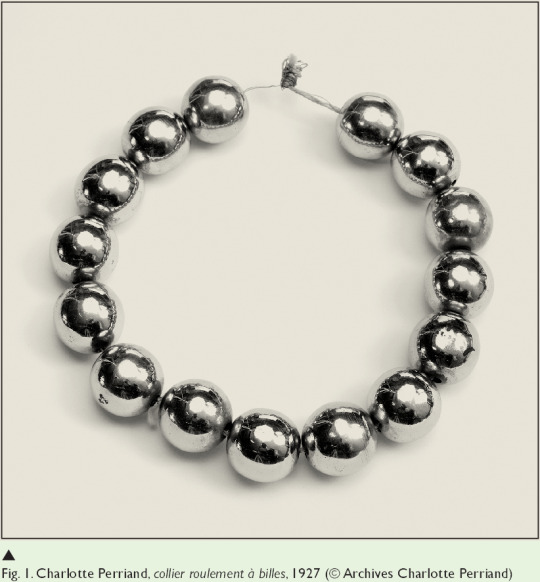
Collier roulement à billes chromées - 1927 | src Semantic Scholar

Detail of the image below. Note the silver choker, known as Collier roulement à billes chromées that Perriand wears.
view and read more on wordPress

Fernand Léger :: Still life, Le Mouvement à billes (1926). Gouache and ink on paper. Signed with initials and dated 26.
Perriand had asked an artisan with a workshop in the Faubourg Saint-Antoine to make the piece out of lightweight chrome steel balls strung together on a cord. The piece was inspired by Fernand Léger's still life "Le Mouvement à billes" (1926).
view and read more on wordPress
#Charlotte Perriand#Fernand Léger#women artists#ball bearings necklace#beaded necklace#avant garde#collier#design#fernand leger#jewellery#1920s#jewelry#modernism#necklace#roulement a billes#women in the arts
44 notes
·
View notes
Text

"Jardin de l'Impératrice Eugénie" (ouvert au public depuis 2007) devant l'entrée de la "Fondation Eugène Napoléon" construite par l'architecte Jacques-Ignace Hittorff (1856) - ancien orphelinat du Faubourg Saint-Antoine à Paris - février 2024.
2 notes
·
View notes
Photo

Boutique de chaudronnier, rue Saint-Jules, à l’angle de la rue du faubourg Saint-Antoine.
1938
13 notes
·
View notes
Photo

1986 Paris, faubourg Saint-Antoine
#1986#Paris#Faubourg Saint-Antoine#rain#filmphotography#analog photography#streetphotography#vintage#1980s#photography#Pierre Wayser
8 notes
·
View notes
Text

#paris#france#streets#people#darkness#light#café#bar#tabac#pmu#loto#bingo#toto#amigo#rue du faubourg saint antoine#75012
5 notes
·
View notes
Text

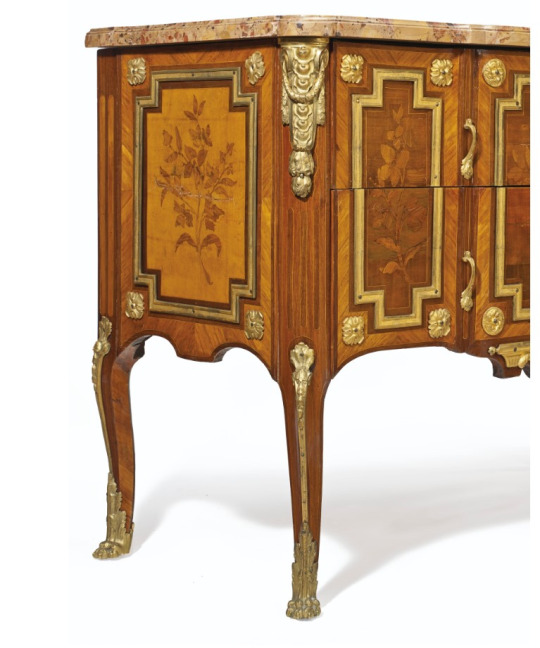
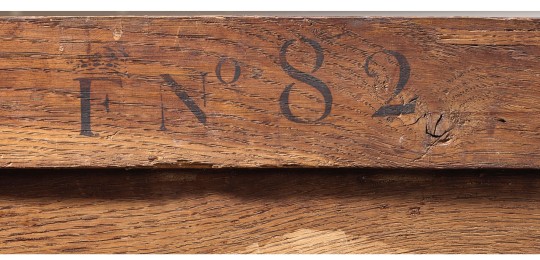
~ "Léonard Boudin (1735 – 20 November 1807) was an independent ebanist who worked in the Faubourg district Saint Antoine of Paris until 1767. Throughout his career, Boudin was recognized for his ability in marquetry, parquets and China lacquer. After receiving the title of Master Ebanist in 1761, his reputation was strengthened from providing a desk to Gilles Joubert (supplier of furniture from the Royal Guardamuebles), for the Count of Provence at the Castle of Compiègne and also a dresser for the Count, in Fontainebleau, in 1771.
Boudin even sells furniture to a number of fellow ebanists, including Pierre Migeon, Gerard Peridiez, Roger Vandercruse (RVLC) and Louis Moreau. After a series of important commissions, Boudin became one of the leading furniture retailers and opened a shop in Froidmanteau Street in the early 1770s. His trade was a combination of businessmen, designers, antiquities, and furniture commissioners who were then important in establishing styles, design, and inspiration for interior decoration in 18th-century France.
As a furniture retailer, Boudin ordered pieces from other leading manufacturers, such as Gilbert, Roussel, Latz, Chevalier, Foullet, Bayer and Topino, whose stamps are found in a series of pieces, with Boudin’s stamp also in its distributor role. Boudin transferred his business to the cloister of Saint-Germain-l'Auxerrois in 1777, at which he left seemingly all activities as an artisan and instead acted only as a distributor.
In addition to furniture, it sells a wide variety of decorative items, from sculptures and candlesticks to exotic curiosities. He also offered his interior design services, as evidenced in his collaboration in the equipment of the Duchess of Arenberg's residence in the street of the Ville-l'Evêque. Some of the most important pieces of furniture bearing the Boudin stamp are in the collections of the Louvre, Carnivalet, Castle of Versailles, Cleveland Museum of Art, Kunts Husgeradskam in Stockholm." ~
3 notes
·
View notes
Text
The 4th of June 1832
The clear day as the sun rose in the sky seemed to be long, drawn and unbearable in terms of heat and without any respite in terms of rain for the Parisians. All through the day Enjolras had been walking across several districts and quarters of Paris, his shoes showed some signs of wear by the evening. As the sun went down, Enjolras waited at his lodgings for the arrival of his friends.
Bahorel and Feuilly knocked on the door softly three times, there was a sound of the latch being removed and the door opened, the fresh face of Enjolras greeted them. He had taken off his cravat, rolled up his shirt sleeves and smoothed out his printer's smock which he wore over loose dark trousers. His black waistcoat and white shirt underneath were still in immaculate condition. His dark blue (almost black) frock coat was laid neatly on the bed.
Enjolras told them that he wanted to air out some words to dry and needed their input, causing their conversation to start with a laugh, not because they hadn’t heard this in casual conversation enough times, Enjolras sometimes used a printer’s language because of habit and also because it was familiar, comfortable and warm. He knew this, and had always greeted his friends in this manner, to see laughter on their faces. They fell to discussing immediate strategy and placement of their groups, once the funeral passed through Faubourg Saint-Antoine.
Combeferre and Joly were still at Necker and Salpêtrière respectively, finishing their shifts, after Combeferre had returned from Picpus in the morning, and Joly from talking to medical students. Courfeyrac was milling outside the cafes and neighbourhoods where polytechnics gathered, and Bossuet was haunting the law school courtyards, engaging the students. Prouvaire had not yet returned after being told to speak to the lodge of the Rue de Grenelle-Saint-Honoré.
Enjolras’ eyes were a little red, his face more brittle, visible lines of concentration and worry were evident on it. He had spent the entire day, after an early meeting with Cougourd d’Aix- with workers around the markets of Saint-Denis and Les Halles; among the hustle and bustle of , men, women, children coming and going, bicycles speeding past, gamins and gamines playing in the street. There was a basket maker’s shop, a fishmonger’s stall, a tailor’s shop and a butcher's shop; several rag pickers were walking around, as well as some hawkers and women who plied their trade as prostitutes. He then walked to Rue Saint-Martin and Rue Aubry le Boucher and made arrangements for a safe house where insurgents could congregate after the riot.
The tocsin of the Saint-Merri Church rang eight or nine times before he thought to make his way back to his lodgings. It was as well as he did that. He had formulated a plan in his head of the best ways to attack and defend the barricades.
He had been hearing stories of workers who were struggling to feed their families, now that cholera was also waging a war on the city. He had heard these stories for the past few months, both from the workers and from Combeferre, and had tried to reassure some of his friends that they were fighting for a change and needed their support. It becomes hard when he seems families, each with a similar affliction of poverty, misery and hunger. Combeferre had talked of bodies of the dead piling in the hospital, going unclaimed in the morgue; they could not even remove them quick enough. Enjolras' thoughts were always turned towards the people, even more after the heartache of July Revolution.
Enjolras has a family, well he has a father, back in Puy, nestled in the Auvergne-Rhône-Alpes Region. Sometimes when he was in a mood, Enjolras could tell an amusing story about his grandfather who had lived a colourful life before settling as a bookseller-publisher after 93.
The business had been successful, the grandfather not only opened a printing press in his home town of Puy but travelled to Paris and with the help of an old friend set up shop in Paris. His uncle had no sons, and his only daughter was married to a man in a different trade who showed little interest in printing. Thus it was that Enjolras had been training as an apprentice since his teen years, having finally graduated from an apprentice journeyman to a journeyman despite the Le Chapelier law, which had banned many guilds and trade unions.
He had been talking to workers in different trades, tailors, joiners, masons, and others, to get a sense of how hard it was for them to form unions or mutual aid societies. Some mutual aid societies were emerging in secret, a few had been discovered and banned and arrests made. Some journeymen allowed to continue on their Tours without much resistance. It depended on how good a master you had. Enjolras shifted his printer's cap in his hands, that is not how it should be.
There was much to fight for still despite a lot of blood having been spilt over centuries fighting for greater rights for workers. He thought back to the Réveillon riots of 89, the dawn of liberty had to be delivered from the birth pangs that had gone on for too long, it was inevitable. It was also late, he sighed wistfully, looking at the clear sky. He felt a stirring of melancholy within him, Prouvaire often talked about that, the one that was the burden of poets and revolutionaries. I am not a poet, he told the sky, and smiled as he felt some raindrops on his face.
For himself, he had found the occupation of a printer-publisher of much use; a Master printer is always in communication with different sections of society, he could set the type (he laughed a little at his own joke) of the entirety of Paris, while also choosing to work against his own class, the petit bourgeoisie.
His uncle did know that he dealt in marrons and chose to not inquire too deeply about which books he was illegally smuggling because Enjolras was a willing and efficient worker. Enjolras had therefore at his ready use, a supply chain which was not just useful for smuggling books under the cloak, so to speak, but for all sorts of revolutionary materials, and which had been honed to a high degree to evade random police inspections.
It was unclear how the conversation had drifted to their own families. Courfeyrac had delivered the box of bullets and cartridges to Enjolras for safekeeping and it was sitting snuggly underneath the floorboards, hidden by the rug. Enjolras had positioned his chair near it.
Courfeyrac was attached to this box, it was his greatest piece of art, he ranked it even higher than a novel or two he had written while bored. His oldest brother had inherited the running of his father’s estate, his second brother had taken the cloth and become a priest, and here he was, the third brother, with his playthings and his mistresses, as his father would say. He did not mind being called frivolous in the least.
Bahorel was sitting opposite him taking up two chairs and striking his favourite pose, Feuilly ended up taking the chair in the middle. There was a thrill in the air, of things having been set into motion- the heat matched the tempers of Paris.
“I feel a thrill of happiness when the community around Saint Denis or Les Halles or Saint-Antoine know that they can turn to me or to any of us,” Feuilly said smiling. “And we may not always know where to turn to, but we find the help needed somehow or we work towards it together. We have made some strides towards the idea of unions, of workshops, of less hours, of children having more time to play and to get an education.” That I could not receive beyond a few classes, he added to himself.
“You have created an ever expanding family around you, my friend.” Enjolras squeezed Feuilly’s hand in his and Feuilly responded by placing his head on his shoulders. The wind from the open window swept through his hair and Enjolras rearranged it for him.
Feuilly looked back over his childhood, the years of uncertainty and longing for love, of living in a foundling hospital, of having the village school master beat him and other children, of being sent as an apprentice to do odd jobs at 12. At being taken in by a kindly fanmaker in Grenoble, and then being passed around to his cousin in Paris. His years were not entirely happy, but he was able to create temporary pockets of familial comfort. He had seen many childrens’ futures disappear under the yoke of labour and the prospect of earning a few sous to feed themselves, but for the kindness of strangers who had welcomed him, his might have followed suit. Tears had started rolling down his eyes, and he let them flow.
Enjolras softened and in the warm glow that the gas lamp threw on his face, looked at them both fondly, “I was going to wait until the others returned but, you, all of you are my family.” He took out his handkerchief, and wiped the tears from Feuilly’s face and then softly and tenderly he hugged him.
Bahorel tried to joke that he was an ardent Philadelphe– midway through the sentence, his voice broke down, choked with deep feelings of love for them both; for all of them, he declared to the entire room, his voice more of a howl than a shout of joy. For the others were always present here with them even when they were scattered around Paris and even if they scattered around the world or became busy in their lives, he would still carry them with him. He was a Romantic after all.
Feuilly had to brush a few odd tears that had strayed in his eyes again at this fresh declaration and outpouring of love from Bahorel. He may have adopted many of the communities as family, but his closest, dearest family were still the ones gathered here. Enjolras too was not immune to the romantic passions in service of revolution and friendship, he hugged them both. The door opened at that instance and Courfeyrac, Combeferre and Prouvaire walked in.
“What, no greeting at the door?” Courfeyrac asked, putting some more rifles and boxes down. Combeferre opened the trap door and hastily moved them all there. “We were waiting there for your usual greeting, aren't you afraid police spies might be trying to enter-” he broke off as he saw their faces full of happy tears and hugged them all.
“I came through a long circuitous route and made sure I wasn’t followed but the police rarely give a second glance to a bourgeois looking gentleman carrying arms,,”Courfeyrac said laughing, putting his hat down and sitting cross legged on the bed. He and others had trailed some mud across Enjolras’ floor, he grinned sheepishly. “I had stashed some arms away from the July Revolution and from my friends who are all into hunting parties.”
They all took their places on the chairs or on the rug on the floor and conversations flew back and forth cheerfully. They were confident and hopeful that they had reasonably managed to do as much preparation as they could in the time they had, which had been only a few days from Galois’ funeral to General Lamarque’s. A day or two’s preparation was all that was often given to prepare for riots in a city that was as much a lover of riots, as Paris was. A day or two was all that was sometimes needed if everything else went to plan.
They had set the powder kegs around the city, only a spark was needed, and Paris had assured them that it was ready for that spark, for that fire. They were talking about the future in high hopes, discussing how they all should take a few days to rest and remain underground once the riot ended, no matter what the outcome. They promised themselves not to burn themselves out, neither on literature (Prouvaire and Bahorel added a resounding ‘hear hear’) nor on political organising.
Everyone turned towards Enjolras, he was lost in thought, hope shining in his handsome face as he gazed quietly at the people around him and beamed. "I will try." he said, laughing and hiding his face. Combeferre squeezed his hand, the strains of Ça Ira broke out in the room.
Enjolras thought he might visit his father in Le Puy and take Combeferre and Courfeyrac with him, Bahorel and Prouvaire had made plans to visit Bahorel’s family in Lyon. The talk had moved to discussing all the various eccentricities of their own families or employers, uncles, aunts and cousins were also not spared, and in Bahorel’s case of the various farm animals too.
They echoed their feelings of mutual adoration towards each other several times, and why should they not? They had survived many years of riots, navigated many differences of opinion and still cherished each others' company and turned to each other for support.
One thing they kept coming back to and were heartily agreed upon, was that if they were not killed in these riots, they were not going to stop from trying to set the city alight to usher in the new dawn.
#barricade preparations#my fic#this is uh from a longer piece#but I couldn't resist posting the 4th and 5th June ones on barricade day#one day more#les mis#I forgot my tags for barricade days#barricade days#barricade day#posting now before I become too terrified of posting
43 notes
·
View notes
Text

.
Tuesday Trivia…. Outside vs Inside the city limit (a long long time ago)
Since the Antiquity, Paris has almost always been surrounded by a wall, hence the expression Paris intra-muros (albeit now meaning the Périphérique).
Etymologically, the word “faubourg” designates a town located “outside the city”, beyond its limits. The suburbs of Paris were therefore villages located beyond the walls of the capital.
Now when you go from Rue du Faubourg Montmartre (or Faubourg Saint-Honoré, or Faubourg Saint-Denis, or Faubourg Saint-Martin, or Faubourg Saint-Antoine, or Faubourg Saint-Jacques, or Faubourg Poissonnière, or Faubourg du Temple) to Rue Montmartre (or Saint-Honoré, Saint-Denis, etc…) by crossing a perpendicular street, you know that a few centuries ago you would have been outside the city limit then passed the wall into the city limit.
2 notes
·
View notes